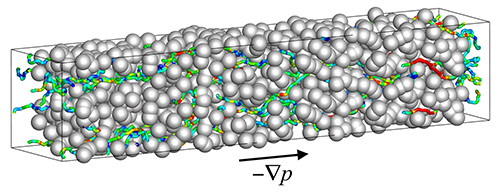Scientists have designed mathematical expressions that more accurately estimate gas movement through nanosized pores. This could help improve fuel cell development.
Many engineered devices depend on the flow of gases through a porous medium. In catalytic converters, for example, harmful automobile exhaust gases pass through a porous medium of ceramic beads coated with a catalyst that converts them into harmless compounds. Also, in fuel cells under development for eco-friendly vehicles, hydrogen and oxygen pass through a porous catalyst that converts them into water, producing electricity.

Fig.1. Streamlines of gas flow through a porous medium induced by applied pressure gradient ∇p. The colour of streamlines represents the strength of flow speed, where red represents fast speed and blue represents slow speed.
Engineers need a clear understanding of how gases move through porous media to improve these devices. However, it is difficult to measure the transport of molecules through nanosized pores.
Researchers at Tohoku University in Japan specializing in rarefied gas dynamics, together with colleagues at Honda R&D Co., Ltd., used computer-based simulations to develop two mathematical expressions that estimate gas flow velocity through a porous medium.
The expressions look like equations, but actually show a physical relationship between flow velocity through a porous medium and pressure gradient, which can aid in understanding molecular transport through porous media. This could help advance development of more environmentally-friendly fuel cells for cars and even for future space shuttles.
The team used the 'direct simulation Monte Carlo (DSMC) method,' which models the flow of low-pressure gas using simulation molecules. In their study, porous media were represented by randomly arranged solid spherical particles. The team investigated what happened when a constant flow of hydrogen molecules were driven through the medium by a steady pressure gradient. Simulations were performed for different porosities and different sizes of solid particles.
The team found that the gas flow velocity through a porous medium increases in proportion to increasing pressure gradient. This shows that Darcy's law, which states that the fluid flow rate through a porous medium is proportional to the pressure gradient, applies even with nanosized pores. However, they found conventional models, such as the Kozeny-Carman equation, which is often used to estimate flow velocity through a porous medium, produced estimates that were different from the results of the DSMC simulations when microsized pores were switched to nanosized pores.
When pores are relatively large, the pressure difference induces gas flow. The flow steadies when the viscous force exerted on the gas at pore walls balances out the force due to the pressure difference. This is called 'viscous flux.' On the other hand, when pores are nanosized, gas molecules cannot sense the pressure difference directly because molecule-to-molecule collisions are much less frequent compared to molecule-to-wall collisions. In this case, gas molecules scatter in random directions after molecule-to-wall collisions. These chaotic molecular motions induce a net molecular flux in the direction of less concentration. This is called 'Knudsen flux.' The reason why the conventional models produced inaccurate estimates in the case of nanosized pores is because only the viscous flux is considered in those models.
The team developed two mathematical expressions that describe gas flow velocity through a porous medium. They regarded a porous medium as a bundle of tortuous capillary tubes, whose diameter is equal to the average distance that a molecule travels between successive molecule-to-wall collisions. Their expressions for a porous medium were constructed by superposing the contributions of both viscous and Knudsen fluxes through the tortuous capillary tubes.
The team found that inputting information such as particle diameter and porosity into these expressions resulted in flow velocity estimates that agreed well with the DSMC simulation results.
"Our expressions will be applicable to any gas with simple molecules and to any porous medium with an arbitrary internal structure," says Tohoku University's Shigeru Yonemura, the study's corresponding author. "This knowledge will be useful not only for fuel cell technologies but also for any technology that involves gas flow through a porous medium. Our next step is to construct a theoretical expression for capillary tube tortuosity. With this, we will be able to complete our expressions to estimate gas flow velocities through any porous medium."
- Publication Details:
- Title: A study on pressure-driven gas transport in porous media: from nanoscale to microscale
Authors: Yoshiaki Kawagoe, Tomoya Oshima, Ko Tomarikawa, Takashi Tokumasu, Tetsuya Koido, Shigeru Yonemura
Journal: Microfluidics and Nanofluidics (2016) 20: 162.
DOI: 10.1007/s10404-016-1829-8
Contact:
Shigeru YonemuraInstitute of Fluid Science
Tohoku University
Email: yonemura@ifs.tohoku.ac.jp
Website: http://www.ifs.tohoku.ac.jp/eng/nfrd_nmgfl.html
